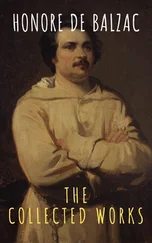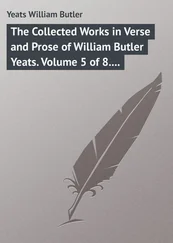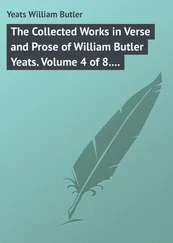So many indications were sufficient to make us follow the right-of-way across Puttenham Heath, and our conjecture was confirmed by our finding at the further edge of the heath, a conspicuous embankment marked by an exact line of three very aged trees, which everywhere indicate the track.
Though it was hardly a road, rough and marked only by ruts in the winter soil and by its rank of secular trees, it was most evidently the Old Road. We were glad to have found it.
When we had passed through the hollow to the north of a few cottages, direct evidence of the road disappeared at the boundary of Monk's Hatch Park, but it was not lost for long. 350 yards further on, laid on the same line, a slightly sunken way reappeared; it ran a few yards below the recently made Ash Path, and led directly by the lane along the south of Brixbury Wood, across the Compton Road, and so by a lane called 'Sandy Lane,' beyond, over the crest of the hill, till, as the descent began, it became metalled, grew wider, and merged at last into the regular highway which makes straight for St. Catherine's Hill and the ferry and ford below it.

ROUGH, AND MARKED ONLY BY RUTS IN THE WINTER SOIL, AND BY ITS RANK OF SECULAR TREES
The Old Road having thus coincided once more with a regular road, we went at a greater pace, observing little of our surroundings (since nothing needed to be discovered), and hoped to make before it was quite dark the passage of the river.
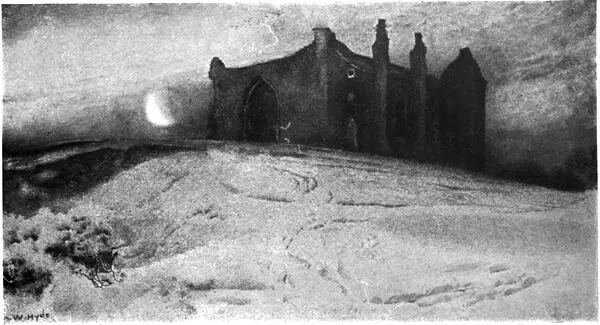
THAT CURIOUS PLATFORM WHICH SUPPORTS IN SUCH AN IMMENSE ANTIQUITY OF CONSECRATION THE RUINS OF ST. CATHERINE'S CHAPEL
Arrived, however, at that curious platform which supports in such an immense antiquity of consecration the ruins of St. Catherine's chapel, we saw that the exact spot at which the river was crossed was not easily to be determined. The doubt does not concern any considerable space. It hesitates between two points on the river, and leaves unmapped about 800 yards of the road; but that gap is, it must be confessed, unsolved so far as our investigation could be carried.
It is certain that the prehistoric road begins again by the north-western corner of the Chantries Wood. Tradition and the unbroken trail hence to St. Martha's hill-top confirm it. The arguments I have used in the last few pages show equally that the road led, on this side of the way, up to the point below St. Catherine's chapel where we were now standing.
It is, moreover, extremely probable that the platform of St. Catherine's was the look-out from which the first users of this track surveyed their opportunities for passing the river, and near to it undoubtedly their successors must have beaten down the road.
The precipitous face towards the stream, the isolation of the summit and its position, commanding a view up and down the valley, render it just such a place as would, by its value for their journeys and their wars, have made it sacred to a tribe: its sanctity during the Middle Ages gives the guess a further credential. But in framing an hypothesis as to how the valley was taken from the descent of St. Catherine's to the rise at the Chantries beyond the stream, one is met by two sets of facts irreconcilable with one another, and supporting arguments each, unfortunately, of equal weight. These facts are few, simple, and urgent; they are as follows:—
Primitive man we must imagine chose, if he could, a ford, and kept to such a passage rather than to any form of ferry. The ford exists. It has given its name 'The Shallow Ford' to the village which grew up near it. The church stands close by. So far it would seem that the road certainly passed over the crest of St. Catherine's, came down to the south of that hill, crossed at Shalford, and reached the Chantries by that passage.
On the other hand a sunken way of great antiquity leads directly from St. Catherine's Hill down to the river. It follows the only practicable descent of the bank. It is in line with the previous trend of the Old Road; at its foot is a ferry which has had a continuous history at least as old as the pilgrimage, and beyond this ferry, the path over the field, and the avenue beyond the main road, lead immediately and without any diversion to that point at the foot of the Chantries Hill where, as I have said, the Old Road is again evident.
From Shalford no such track is apparent, nor could it be possible for a passage by Shalford to be made, save at the expense of a detour much sharper than the Old Road executes in any other part of its course.
In the face of these alternatives no certain decision could be arrived at. The medieval route was here no guide, for it had already left the road to visit Compton, and was free to use Shalford ford, the ferry, or even Guildford Bridge—all three of which the pilgrims doubtless passed indifferently, for all three were far older than the pilgrimage.
It may be that the ferry stands for an old ford, now deepened. It may be that the passage at Shalford was used first, and soon replaced by that of the ferry. We knew of no discoveries in that immediate neighbourhood which might have helped us to decide; we were compelled, though disappointed, to leave the point open.
It was now quite dark. My companion and I clambered down the hill, stole a boat which lay moored to the bank, and with a walking-stick for an oar painfully traversed the river Wey. When we had landed, we heard, from the further bank, a woman, the owner of the boat, protesting with great violence.
We pleaded our grave necessity; put money in the boat, and then, turning, we followed the marshy path across the field to the highway, and when we reached it, abandoned the Old Road in order to find an inn.
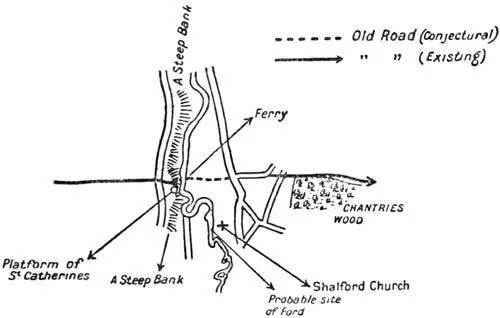
We slept that night at Guildford, whence the next morning, before daylight, we returned up the highway to the spot where we had left the Old Road, and proceeded through the gate and up the avenue to follow and discover that section of the road between the Wey and the Mole which is by far the richest in evidences of prehistoric habitation—a stretch of the Old Road which, partly from its proximity to London, partly from its singular beauty, partly from its accidental association with letters, but mainly from the presence of rich and leisured men, has been hitherto more fully studied than any other, and which yet provides in its sixteen miles more matter for debate than any other similar division between Winchester and Canterbury.
Shalford to Dorking Pits
Eleven miles
The Old Road leaves the Guildford and Shalford highway on the left, or east, in a line with the path which has reached it from the ferry. We passed through a gate and entered an avenue of trees, at the end of which the newer road which has been built along it turns off to the left, while the Old Road itself, in the shape of a vague lane, begins to climb the hill. The light was just breaking, and we could follow it well.
At this point, and for some distance further, it is known to historians and antiquaries, and preserves, moreover, many indications of that use whereby the medieval pilgrimage revived and confirmed its course. It skirts by the side of, and finally passes through, woods which still bear the name of the 'Chantries,' and climbs to that isolated summit where stands the chapel of St. Thomas: 'the Martyr's' chapel, which, in the decay of religion and corruption of tradition, came to be called 'St. Martha's.'
Читать дальше











